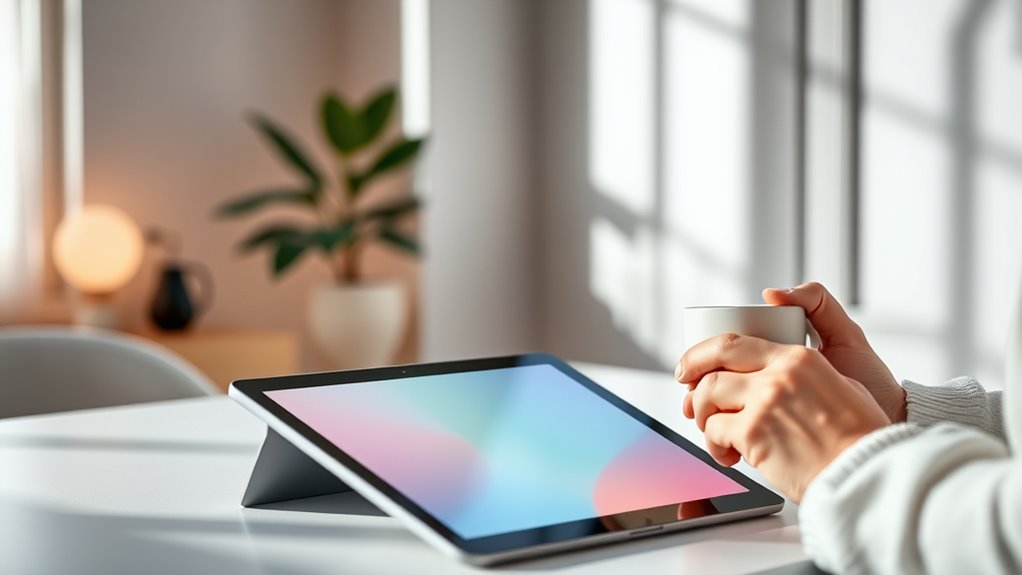To fight screen fatigue, focus on designing digital spaces that prioritize your comfort and mental health. Use mindful notifications that appear only when necessary, reducing unnecessary distractions, and incorporate ergonomic interfaces that adjust to your natural posture and visual needs. Include features like break reminders and interface adaptations that align with your circadian rhythms to prevent eye strain and fatigue. If you want to learn how thoughtful design can foster balance and resilience, there’s more to discover.
Key Takeaways
- Implement mindful notifications that appear only when necessary to minimize interruptions and mental overload.
- Design ergonomic interfaces with adjustable font sizes and contrast for comfortable, long-term device use.
- Incorporate features like blue light filters and break reminders to reduce eye strain and support healthy sleep patterns.
- Use subtle cues and reduced alert frequency to help users regain control over digital interactions and lessen stress.
- Foster a balanced digital environment by encouraging mindful platform choices and promoting regular digital breaks.

Have you ever wondered how your digital environment affects your mental health and daily life? The way you interact with screens, notifications, and interfaces can substantially influence your mood, focus, and overall wellbeing. One key aspect of designing for digital wellbeing involves creating mindful notifications. Instead of bombarding you with constant alerts that pull you away from tasks or relaxation, mindful notifications are intentionally crafted to inform without overwhelming. These notifications appear only when necessary, using subtle cues that respect your attention span and mental space. By reducing the frequency and intrusiveness of alerts, you regain control over your digital interactions and avoid the stress of constant interruptions. Incorporating attention management strategies into interface design further helps you stay present and avoid cognitive overload, supporting sustained focus and mental clarity.
Alongside mindful notifications, ergonomic interfaces play an essential role in promoting your mental health. These are designs that prioritize your comfort and ease of use, minimizing physical strain and cognitive load. Think about how often you strain your eyes or hunch over your device; ergonomic interfaces aim to eliminate those issues by adjusting font sizes, contrast, and layout to suit your natural posture and visual comfort. From adjustable text sizes to intuitive navigation, these design choices help you use devices longer without discomfort. When interfaces are ergonomic, you’re less likely to experience fatigue, frustration, or anxiety, making your digital experience more sustainable and enjoyable.
Ergonomic interfaces reduce physical strain, making digital use more comfortable and sustainable for your mental and physical health.
Designing for digital wellbeing also involves considering how your environment influences your screen time. For example, interfaces that adapt to your circadian rhythm can help you wind down at night, reducing exposure to blue light and encouraging healthier sleep patterns. additionally, integrating features like break reminders prompts you to step away periodically, preventing eye strain and mental exhaustion. These small but impactful design decisions collectively support your mental clarity and emotional resilience, especially during long hours of work or leisure.
Your digital environment should empower you, not drain you. When developers incorporate mindful notifications and ergonomic interfaces, they create spaces that respect your mental boundaries and physical needs. This approach fosters a healthier relationship with technology, allowing you to stay productive and connected without sacrificing wellbeing. As you engage with digital devices, choose platforms and apps that prioritize your mental health through thoughtful design. By doing so, you’re not just fighting screen fatigue—you’re actively cultivating a balanced, mindful digital lifestyle that enhances your overall quality of life.
Frequently Asked Questions
How Can Developers Measure Digital Wellbeing Impact Effectively?
You can measure digital wellbeing impact effectively by tracking user engagement patterns and analyzing data analytics. Focus on metrics like screen time, session frequency, and feature usage to identify improvements in user behavior. Regularly collect feedback through surveys or app prompts, then interpret this data to refine your design. This approach helps you understand how well your efforts reduce screen fatigue and promote healthier digital habits.
What Role Do User Feedback and Testing Play in Wellbeing-Focused Design?
User feedback and testing are essential for wellbeing-focused design because they help you understand how real users experience your product. By practicing user-centered design, you ensure your solutions meet actual needs. Incorporate iterative feedback to refine features that reduce screen fatigue and promote healthy habits. Regular testing allows you to spot issues early, making your design more effective and aligned with users’ digital wellbeing, ultimately creating a more balanced digital experience.
How Can Accessibility Considerations Enhance Digital Wellbeing?
You might think accessibility complicates design, but it actually boosts digital wellbeing. Inclusive design guarantees everyone, regardless of ability, can navigate comfortably without stress or fatigue. Incorporate assistive technologies like screen readers and adjustable text sizes to reduce strain. When you prioritize accessibility, you create a more welcoming environment that minimizes frustration, helping users feel more in control and less overwhelmed, ultimately promoting healthier digital habits and reducing screen fatigue.
Are There Specific Industries More Prone to Screen Fatigue Issues?
You’re more likely to encounter screen fatigue in industries like workplace wellness and entertainment apps, where prolonged screen time is common. In workplace wellness, employees often face back-to-back virtual meetings and health tracking apps, increasing eye strain. Similarly, entertainment apps keep users engaged longer, leading to fatigue. To combat this, prioritize features that promote breaks, adjustable brightness, and user-friendly interfaces to foster healthier digital habits.
How Can Digital Wellbeing Principles Adapt to Emerging Technologies?
You can adapt digital wellbeing principles to emerging technologies like Augmented Reality by prioritizing user comfort and minimizing distractions. Incorporate features that reduce eye strain and limit continuous use. Address Privacy Concerns by giving users control over their data and transparent information about how their info is used. This way, you guarantee that new tech supports wellbeing without sacrificing privacy, making digital experiences healthier and more trustworthy.
Conclusion
By intentionally designing your digital experiences, you can reduce screen fatigue and promote wellbeing. Imagine a social media app that gently encourages you to take breaks with calming visuals and usage reminders. Just like that, you can create tools that support healthier habits instead of overwhelming you. When you prioritize thoughtful design, you empower yourself to enjoy technology without sacrificing your mental health. Small changes can make a big difference—start designing with wellbeing in mind today.









